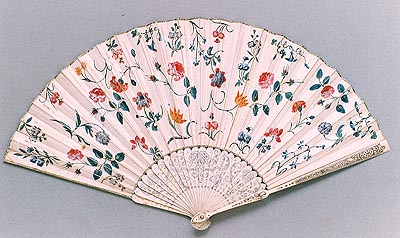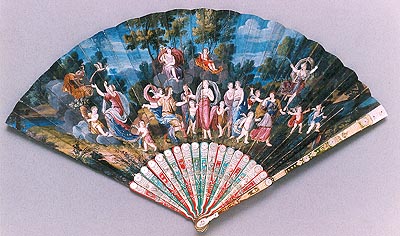The earlier rigid fans which had been introduced in the mid 16th century gradually lost favour in fashion for the folding fan and by the mid 17th century they were only a memory.

In 1600 England formed the great trading company, known to history as the East India Company to exploit and develop trade in the East. A fascination with the east had been evident in Europe since Marco Polo’s journey to Cathay, and it was in full bloom again by the Renaissance at the court of Elizabeth of England. Elizabeth 1st is known to have owned Indian jewellery and masques celebrating the exotic had been a constant of court life since the days of Henry VIII. The East India Company fuelled this quest for the exotic, and its minutes, even as early as 1614 indicate that fans were being exported to Europe to fuel these crazes for the exotic and unusual.
By the end of Elizabeth’s reign in England in 1603, Fans were firmly established as a fashion accessory for the very rich in the courts of Europe, and locally made fans had started to be supplemented with imported fans from the mysterious East.
Close examination of early 17th century portraits of women carrying folding fans reveals a constant factor in their span: they are wedge-shaped, opening at an angle of between 35 to 45 degrees. This certainly suggests an Asian prototype as Chinese fans of this period have the same shape. European manufacturers may have been inspired by their oriental counterparts, but they did not slavishly copy them. What fans of this period have survived show a great variety in their leaf sizes and stick lengths. Surviving English and Dutch folding fans of the early 17th century have a naïve quality which does not exist in their sophisticated French and Italian counterparts. A distinctive feature of some of these fans is the slotting of the sticks into the leaf, as though the fan maker were treating the vellum or other material used as a textile or wide piece of ribbon.
A classical education was no longer solely restricted to the Aristocracy. More and more women were literate and this was reflected in the subjects showing up on fan leaves. Silk, fine kid or vellum was used for fan leaves, with perhaps the added lustre of Mica. A thin glass-like material, Mica was an often distinctive feature of surviving fans of the mid to late 17th century (one can still be seen, dated c1665 as part of the Messel-Rosse Collection in the Fitzwilliam Museum in Cambridge.)

Gradually flowers and floral subjects were relegated to the reverse of the leaf, while the obverse (front) was treated increasingly as a picture, the subject often being copied from, or derived from, famous paintings. Favoured subjects came from mythology, the Bible and Roman history. Fans of this type were being produced in Italy from at least as early as the 16th century and exported throughout Europe.
During the mid 17th century England faced a period of austerity during Cromwell’s rule. This is reflected in the clothes and fashions of the time and little is known of fans during this period. With the return of Charles II to the throne in 1660 in England, there was a revival of interest in fashion at court and fans. Nor were they cheap. They were in equivalent prices, at least the third of the price of a fine suit.
By the third quarter of the 17th century Paris and Versailles were becoming the centre for fashionable and luxury taste, a position Paris has held on and off ever since. In 1673, an Association de Eventaillistes was formed with the king as its patron. To qualify as a member, the fanmaker was required to serve 4 year’s apprenticeship and sometimes produce a chef d’oeuvre. The entrance fee was 400 Livres. Widows could inherit their husband’s membership if they did not remarry. There were 60 founder members.
In 1685, the revocation of the Edict of Nantes by Louis XIV of France, resulted in an massive influx of Protestant immigrants from France to neighbouring Protestant countries, including England, Holland and Prussia, including all the Protestant members of the Association de Eventaillistes. This event was to have a great effect in the arts in the coming century. A majority of these immigrants were skilled craftsmen who bought to their new homelands the skills and products which had made France famous.
The French Academie, founded in 1648 had specific rules as about the hierarchy of subjects for painters. According to these guidelines fan painters (at the bottom of the heap) could not paint ‘history’, ‘portraits’ or ‘landscapes’. Surviving leaves of the period indicate that these rules were adhered to by treating subjects in a semi-allegorical style or as theatrical performances. These fans often have a dark background to scenes depicted on their leaves. This is a reflection of the large scale paintings being produced during the period. The Baroque movement was one of freedom where art was designed to evoke an emotional response from the viewer, and great contrasts in light and dark were a favoured method of producing this.

On Italian fans the subject matter was unrestricted and sticks and guards became increasingly elaborate. Piqué-work and fine inlay ornament on the tortoiseshell, Mother of Pearl and ivory sticks were appreciated in England as much as France. By this stage fan leaves had grown in size from the small angles of the early part of the century to a size of 45cm (18in).
In the first half of the 17th century fans gradually changed from being items exclusive to royalty and the aristocracy to being items of fashion that any woman of substance wanted to own. Fixed fans gradually faded from favour till they were completely replaced by folding fans. The subjects on the leaves (history, bible subjects etc) reflected prevailing attitudes in painting. In this sense fans are a distorted reflection of the great artists of the period, and the preferred style of painting at any given time can date a fan almost as surely as the sticks used.
Sources:
- ‘Fans’ by Nancy Armstrong, Published by Souvenir Press, 1984
- ‘Fans’ by Susan Mayor, published by Charles Letts, 1990
- ‘Unfolding Beauty – The Art of the Fan’, by Anna Gray Bennett, published by Thames and Hudson, 1988
- ‘Fans from the Fitzwilliam’, By Nancy Armstrong, Published by the Fitzwilliam Museum, Cambridge, 1985
